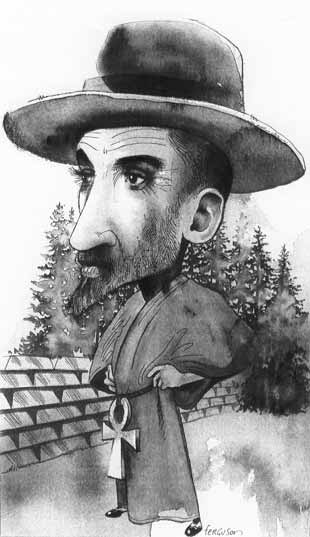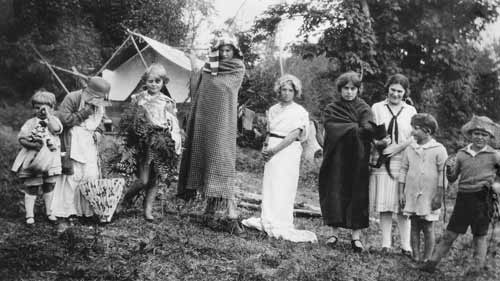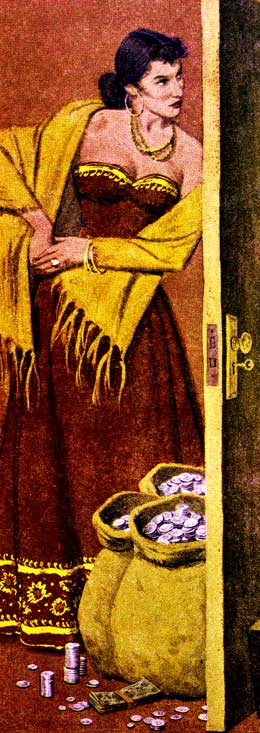 Offshore from Nanaimo, on the east side of Vancouver Island, a string of lesser islands lines the edge of Georgia Strait: De Courcy, Valdes, Thetis, Ruxton. Treasure hunters eye the area speculatively—somewhere there, they say, a great trove of golden treasure may still be buried, the legacy of the messianic cult leader known as Brother XII. Others think the good Brother’s only legacy is the crumbling wrack of a few cabins and outbuildings, since no self-respecting cult leader would ever leave the money behind. The greatest legacy, though, has to be the legend itself.
Offshore from Nanaimo, on the east side of Vancouver Island, a string of lesser islands lines the edge of Georgia Strait: De Courcy, Valdes, Thetis, Ruxton. Treasure hunters eye the area speculatively—somewhere there, they say, a great trove of golden treasure may still be buried, the legacy of the messianic cult leader known as Brother XII. Others think the good Brother’s only legacy is the crumbling wrack of a few cabins and outbuildings, since no self-respecting cult leader would ever leave the money behind. The greatest legacy, though, has to be the legend itself.
Brother XII’s messianic career played out in Canada, but he was born in Birmingham in 1878, with the less interesting name of Edward Arthur Wilson. His schtick was rooted in Theosophy; in fact, his own account of his past mirror Madame Blavatsky claims about her past: he was a sea-captain, he said, whose voyages had been punctuated by pilgrimages to the mystic places of the east, where he studied Eastern wisdom under the Ascended Masters.
Then, in 1924, tossing on a sickbed in Europe, he had a revelation. He was the reincarnation of the Egyptian god Osiris, Lord of the Underworld, and also a member of Blavatksy’s White Lodge—the twelfth member, hence the name he now assumed. Thus, he was a Mahatma himself, but also an emissary from the White Lodge, entering the physical realm with a grave message and mission. The old order of the world was going to end soon, in fire and violence, starting with a fierce depression, and carrying on with a devastating collision with the rogue planet Aquarius. Brother XII’s task was to gather a band of the pure-hearted and build them a refuge in the wilderness, where a new generation of pure, wise children could be conceived and raised, to emerge after the apocalypse into a new millennium. For some reason, that bit British Columbia was slated to survive the catastrophe.
Wilson arrived in Toronto in 1927 with not much in his pocket, but a reputation that preceded him, based on some startling Theosophical papers he had published in England. The Theosophical Society in Toronto welcomed him with mixed interest, but enough well-heeled North Americans were stirred by his message—and terrified by his apocalyptic vision—that he was able to collect a large amount of money and carry through with his grand plan. These backers included a rich American called Mary Connally, who eventually gave him her entire fortune; and a KKK-sympathizing American senator, Thomas Heflin, who was interested enough that there was a chance at one point Brother Twelve would get high-level political backing. This fell through, but the grand plan was able to go ahead: to set up an organization called the Aquarian Foundation, with several branches in Canada and the US, and to buy a refuge.

The selected haven was in British Columbia, on Vancouver Island close to Nanaimo, and including the adjacent islands, DeCourcy, Valdes, and Ruxton. What played out there was a little Jonestown, minus the mass suicide at the end. It began beautifully, with 2500 happy believers handing all their assets over to Brother XII and following him into the wilderness to build their refuge from the coming doom. The colony rose rapidly, within less than a year of Brother XII’s arrival—and then, almost as rapidly, it all went wrong. Brother Twelve’s followers, stripped of their cash, became slave labour, terrorized, overworked, underfed, sexually exploited and kept in a constant state of dread over the imminent apocalypse. At the same time, Brother Twelve stocked up on armaments and built fortifications on the island, with guard towers keeping watch on the channels.

Within this fortified haven, Brother Twelve made free with his female followers. He took a succession of mistresses, including married women with the helpless consent of their husbands, to his “House of Mystery”, a place normally forbidden to the others. The fate of one of these consorts was classic: she had a miscarriage, went mad, and was sent away penniless. But the true consort, in the sense of a partner who exercised as much power over the followers as the messiah himself, was an English-born Saskatchewan-raised ex-schoolteacher divorcee named Mabel Rowbotham Skottowe—known more elegantly to the disciples of Brother Twelve as “Madame Zee.” She turned into a taskmistress even harsher than Brother Twelve, pathologically sadistic and controlling, the Ilse Koch of Vancouver Island with a bullwhip and a foul mouth.
Then there was the gold. Remarkable amounts of cash flooded in, to the point where Brother XII took to burying gold coins in quart jars, ritually (and physically) sealed with the help of Madame Zee. Up to 43 jars are rumoured, valued at upwards of half a million dollars, but there was enough money left over to buy and refit a 25-ton trawler (the Lady Royal) and a tugboat. Things were rosy for the happy couple, but miserable for the rest.
Things came apart in 1930. A few disenchanted members escaped and went to the courts with tales of abuse, slavery, and financial irregularity. Enraged, Brother Twelve and Madame Zee kicked the rest of the faithful out of the homestead they had built with their own hands, leaving them bewildered, tormented, and penniless, but still under Brother Twelve’s thrall. Left alone, the two of them destroyed as much of the colony as they could, including scuttling the Lady Royal. And then they took the tugboat, and sailed away into legend.
They almost certainly took the jars of gold with them, but the tales of buried treasure lingered on for decades, along with the remains of the colony’s infrastructure. The saddest remnant, though, was a number of the colonists, who—however impoverished and disillusioned—hung around because they never could shake off Brother Twelve’s spell, and hoped that someday he would return and make things good again. When and where he died is unknown, but 1934 in Switzerland is the best guess. Madame Zee’s fate is unknown.
Recap of Brother XII’s cult-messiah characteristics:
- had a revelation while sick
- predicted the end of the world
- promised a refuge to those who would support him
- took everybody’s money
- slept with all the women
- conferred almost equal power on a consort
- vanished, leaving great clouds of cognitive dissonance in his wake.
